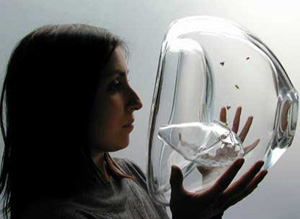

Design for Debate
Design for Debate.
As biotech and other advanced technologies move out of the laboratory into the marketplace there is a need now, more than ever, to explore the cultural, social and ethical implications of emerging technologies.
Design today is concerned primarily with commercial and marketing activities but it could operate on a more intellectual level. It could place new technological developments within imaginary but believable everyday situations that would allow us to debate the implications of different technological futures before they happen.
This shift from thinking about applications to implications creates a need for new design roles, contexts and methods. It's not only about designing for commercial, market-led contexts but also for broader societal ones. It's not only about designing products that can be consumed and used today, but also imaginary ones that might exist in years to come. And, it's not only about imagining things we desire, but also undesirable things -- cautionary tales that highlight what might happen if we carelessly introduce new technologies into society.
The following design proposals by recent graduates of the MA Design Interactions Course at the Royal College of Art explore different ways thought experiments and 'what if...' scenarios can be used -- not to predict or anticipate the future -- but as tools to help us understand and debate the kind of world we want to live in.
Michael Burton pushes the edges of speculative design. His projects, The Race and Future Farm, challenge the current healthcare model of isolating ourselves from the ecosystem. A system which is currently in crisis as antibiotics are often no longer effective, and untreatable super bugs like MSRSA have begun to emerge.
Michael sets out an alternative vision for health care based on reconnecting ourselves to the ecosystem. It's a purposely provocative position. The ideas behind the project are informed by David Strachan's Hygiene Hypothesis and Graham Rook?s Microbial Exposure Hypothesis, better known as the Old Friends Hypothesis.
His projects ask us to reconsider ourselves as more than just our DNA, but as an highly complex co-evolved organism, part animal part conglomeration of bacteria, microbes and parasites.
The projects use a number of short films, photographs and objects to take us from an alternative present to a distant future.
The first idea explores the use of maggots to clean up wounds after surgery. If they were to be used, they would save huge amounts of money and increase a patient?s recovery rate. But for most people, maggots are disgusting and not the sort of thing we?d like keep on, or even, in our bodies despite the benefits.
In his second scenario, Michael explores biophilia clinics. These are places people could go to increase their exposure to animal dirt and microbes. Our favourite is the lamb with extra long hair that when it shakes its head exposes patients to a flurry of bacteria and microbes -- that we would never normally be exposed to in our over-sanitised and hyper-clean environments -- with the intention of making our rather fragile and eroded immune systems more robust.
Looking further into the future, Michael outlines a scenario where people voluntarily offer their bodies up for pharming. For instance the body might be used to produce chemicals for new medicines.
In the last and most futuristic scenario, people lead an almost fully integrated existence with nature. Finger nails have mutated to pick up more dirt, an exaggeration, but necessary to make the point, and coarse facial hair is used to create cages for crickets and other insects which share our bodies and symbolise our reintegration back into nature.
Although set in the near and distant future, these are by no means predictions or forecasts, their purpose is to spark debate about how our relationship to nature might change in the face of new technological possibilities and problems with existing approaches to drugs and healthcare.
Marei Wollersberger's Child Force is a cautionary tale about the future of childhood presented through a highly aestheticised photo story. It explores the impact of gene technology and its ensuing ideology in relation to our current move towards heightened surveillance. Child Force, a dark version of today?s Scouts and Girl Guides, is organised around games and activities for seeking out children with unusual and possibly aberrant behaviour and capturing their DNA for analysis. It invites us to consider questions such as: If scientific findings could be used to decode DNA, will today's children be the first to undergo genetic tests for socially undesirable traits? Would children with 'clean' DNA gain superior status? Could we use genetic engineering to finally make our dream of a safe society reality?
Susanna Soares? projects all explore the idea of new organs of perception. During the project she discovered some research into the use of bees to detect explosives. They can be trained in minutes and can also detect hormones and other chemical traces produced by the human body when ill or at different stages of the fertility cycle.
One of the more striking proposals to come from her project was for an alternative means of diagnosis, less technical and invasive, but also less precise. Bees trained to detect a particular hormone would be placed in a specially designed glass container, the person breathes into a smaller open chamber within the larger one, if the bees detect the hormone they move into the smaller space indicating its presence.
Like the others, this project is more about opening up a discussion than proposing a real product, in this case, about different ways of living with natural systems, and using insects as bio-sensors.
Although in many cases we can't design actual bio-products yet, as these projects show, we shouldn't let that stop us from getting involved. Speculative designs like these can inspire, raise awareness, stimulate discussion, and provoke debate, all of which can help achieve technological futures that reflect the complex, troubled people we are, rather than the easily satisfied consumers and users we are supposed to be.